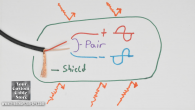I would like to introduce our informative video: Wire Types – Part 1
Here are some details from the video:
Microphone Wires:
It is used for Microphone connections and balanced line-level gear connections, which includes most connections.
If you are referring to it, technically, it is actually “single pair” or “one pair” shielded.
It consists of two wires in the form of a twisted pair with an overall shield.
It can carry a balanced signal, which is best for rejecting noise.
The signal is carried on the pair of wires, and the shield is used to help insulate the pair from noise.
Commonly terminated with XLR connectors, TRS 1/4″ connectors, and less commonly with Euro connectors, TRS 1/8” connectors, and TA3 Mini XLR connectors.
It can also carry a stereo signal, with one wire being the left and the other being the right and the shield being common.
Instrument Wires:
It is used for instruments, instrument interfaces, unbalanced gear connections, and more.
It is technically a coaxial cable with a center conductor that is jacketed and then surrounded by a conductive PVC layer and then the shield.
The center conductor carries the signal, and the shield is the signal ground.
The conductive PVC layer is designed to reduce noise in high impedance applications like many guitars.
You will commonly find this cable terminated with TS 1/4″ connectors and RCA connectors.
Speaker Wires:
They are designed to carry a higher voltage, higher current signal.
Most speaker cables are 2 conductor cables that connect the plus and minus of the speaker to an amp.
It is not uncommon to find 4, 6, and 8 conductor cables for bi-amp systems and multi-cabinet systems.
Regular speaker cables do not have a shield because the voltages do not warrant a shield.
Speaker cables commonly come in two forms, zip cord or also called figure 8, and overall jacket.
You will commonly find speaker cables with TS 1/4″ connectors, banana connectors, Speakon connectors, bare ends, and more.
Unbalanced Wires:
Unbalanced cable and instrument cable have a lot in common. Both are coaxial cables with a center conductor and a shield, but the unbalanced cable does not have the extra conductive PVC layer.
Without the conductive PVC layer, it is not recommended for high impedance applications. However, it is still perfect for all other unbalanced applications like gear connections, stereo connections, unbalanced mic connections, and more.
The center conductor carries the signal, and the shield is the signal ground.
You will commonly find this cable terminated with TS 1/4″ connectors and RCA connectors.

